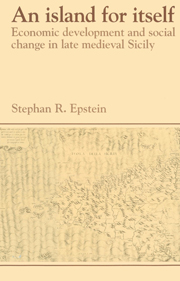Book contents
- Frontmatter
- Contents
- List of maps
- List of tables
- Acknowledgments
- Abbreviations
- Currency and measurements
- Chronology
- 1 Introduction. The historiography and the sources
- 2 Regional geographic and demographic differentiation
- 3 Market structures and regional specialization
- 4 Sicily and its regions. Economic growth and specialization
- 5 Sicily and its regions. Eastern val Demone and the southern mainland
- 6 Foreign trade and the domestic economy
- 7 Income distribution, social conflict and the Sicilian state
- 8 A further question: the origins of Sicilian underdevelopment
- Bibliography
- Index
- Past and Present Publications
7 - Income distribution, social conflict and the Sicilian state
Published online by Cambridge University Press: 06 January 2010
- Frontmatter
- Contents
- List of maps
- List of tables
- Acknowledgments
- Abbreviations
- Currency and measurements
- Chronology
- 1 Introduction. The historiography and the sources
- 2 Regional geographic and demographic differentiation
- 3 Market structures and regional specialization
- 4 Sicily and its regions. Economic growth and specialization
- 5 Sicily and its regions. Eastern val Demone and the southern mainland
- 6 Foreign trade and the domestic economy
- 7 Income distribution, social conflict and the Sicilian state
- 8 A further question: the origins of Sicilian underdevelopment
- Bibliography
- Index
- Past and Present Publications
Summary
Up to this point, I have adopted an institutional approach to economic history which emphasizes the impact of political structures on economic development and growth. In this chapter we shall take the opposite line. Rather than viewing the economy merely as an enabling ‘base’, whose function it is to supply resources for, or set constraints upon, statecraft and administration, we shall examine how economic development transformed social structures, and how these transformations were given political and institutional shape.
A striking feature of the debate on the late medieval European crisis is the lack of communication between economic and social, and political and institutional historians. This barrier has many sources, most of which are not restricted to our debate. A more specific reason for non-communication, however, may be the two fields' seeming intellectual dissonance over the nature of the crisis. Whereas socio-economic historians emphasize destruction, contraction and decline, politico-institutional historians prefer to stress the innovations that emerged from the crisis, particularly the broader range of social classes and interest groups that found representation within increasingly complex institutional structures.
If one takes the latter as a broad characterization of late medieval state formation, its connections with the model of socio-economic change outlined in previous chapters are immediately apparent.
- Type
- Chapter
- Information
- An Island for ItselfEconomic Development and Social Change in Late Medieval Sicily, pp. 314 - 401Publisher: Cambridge University PressPrint publication year: 1992



